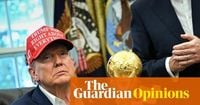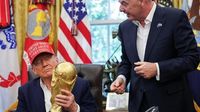On December 5, 2025, the world’s most-watched sporting spectacle will take an unexpected detour to Washington, D.C., as the Kennedy Center—best known for its cultural performances—transforms into football’s grandest stage for the draw of the 2026 FIFA World Cup. The announcement, made in a blaze of political theater at the White House, saw U.S. President Donald Trump and FIFA President Gianni Infantino posing with the iconic World Cup trophy, setting the tone for an event that’s already rewriting the history books.
This isn’t just another routine draw. With the eyes of nearly a billion viewers expected to tune in, the Kennedy Center will become the nerve center of world football, if only for a night. As Infantino put it during the Oval Office announcement, “The draw will be broadcast live all over the world and will be watched by one billion viewers.” It’s a far cry from the Las Vegas Sphere, the venue many had pegged for this moment—echoing the 1994 event—but, as Trump now chairs the Kennedy Center, the choice seems anything but accidental.
The symbolism is impossible to miss. The United States, which last hosted the World Cup in 1994, is doubling down on its soccer legacy by orchestrating the largest and most ambitious tournament in FIFA’s history. This time, the U.S. won’t go it alone: Canada and Mexico join as co-hosts, marking the first time three nations have shared the honor. The scale is staggering—48 teams (up from 32) will compete across 16 cities, with the U.S. fielding 11 venues, Mexico three (Mexico City, Guadalajara, Monterrey), and Canada two (Toronto and Vancouver).
The tournament kicks off on June 11, 2026, at Mexico City’s legendary Estadio Azteca, a venue steeped in World Cup lore, before culminating in the final at MetLife Stadium in New York/New Jersey on July 19. In total, 104 matches will unfold—“104 Super Bowls in a single month,” as Infantino quipped, underscoring the logistical and commercial scale of this expanded World Cup.
But before a single ball is kicked, the draw at the Kennedy Center will set the stage, determining which teams will clash in the group stages. The new format, with 12 groups of four, means the top two from each group and the eight best third-placed teams will advance to a round of 32. It’s a system designed to maximize global participation and keep the drama alive deep into the tournament. Every ping-pong ball drawn on December 5 will dictate journeys, rivalries, and dreams for millions of fans worldwide.
Yet, the drama isn’t confined to the field. Trump’s fingerprints are all over this event—politically, symbolically, and even physically. Not only is he chairman of the Kennedy Center, but he’s also hinted at renaming it the “Trump Kennedy Center.” During the announcement, Trump wore his signature “TRUMP WAS RIGHT ABOUT EVERYTHING” hat and didn’t shy away from the spotlight. “It’s the biggest, probably the biggest event in sports,” he declared. When Infantino handed him the World Cup trophy, Trump jokingly asked, “Can I keep it?”—a moment that blurred the lines between statesmanship and showmanship.
Infantino’s willingness to accommodate Trump’s gestures was on full display. “Since you are a winner, of course, you can as well touch it,” the FIFA president said, referencing Trump’s penchant for the spotlight. Trump even gifted Infantino a ceremonial ticket to the World Cup final—row 1, seat 1—further cementing their public camaraderie. The pair’s relationship has become a recurring subplot, with Infantino having met Trump at least eight times since January 2025, five of those at the White House.
Political undertones have seeped into the event’s planning. Trump has promised “total security” for the draw and hinted that visa policies could be influenced for some countries, a statement that’s already sparked diplomatic speculation. “He has already promised ‘total security’ for the draw and hinted at making visas ‘easier for some countries and more difficult for others’—a statement that underscores how football can become entangled with diplomatic tensions,” reports one source. The event will be attended by representatives from all 16 host cities, ambassadors, and international delegations, turning the draw into a global summit where sport, politics, and show business collide.
The Kennedy Center itself will undergo a dramatic transformation for the draw, shifting from its traditional role as a performing arts hub to a football arena, if only for a night. Infantino described it as the ideal setting to “unite the world.” Yet, with Trump’s direct involvement in the venue’s management and his desire to leave a lasting mark—perhaps even a gold-encrusted one, given his taste for opulence—the event is as much about political theater as it is about football.
Canada and Mexico face their own unique challenges and opportunities. For Mexico, the 2026 tournament will be a record third time as host, with the Azteca standing as a symbol of continuity and footballing heritage. Canada, meanwhile, will be making its debut as a World Cup host, and all eyes will be on Toronto for its first-ever match. Each country brings its own flavor and logistical hurdles, but together, they’re tasked with delivering the biggest World Cup ever staged.
The U.S., meanwhile, is looking to surpass the legacy of 1994, when the World Cup sparked a new era of soccer enthusiasm stateside. Back then, the tournament featured just 24 teams and was hailed as a public triumph. Now, with double the host cities and twice as many teams, the stakes—and the expectations—are higher than ever. The 2026 World Cup promises to shatter records for attendance, television audiences, and revenue, further entrenching soccer’s place in the American sporting landscape.
For all the political spectacle and behind-the-scenes maneuvering, the heart of the World Cup remains unchanged: a celebration of the world’s game, a chance for nations to dream, and for fans to witness indelible moments of joy, heartbreak, and unity. The draw at the Kennedy Center will not crown a champion, but it will chart the course for every team’s journey—and set the tone for a tournament that’s already breaking new ground.
As the countdown to December 5 accelerates, anticipation is building. The Kennedy Center will soon host a night where football’s future is decided, and where the worlds of sport, politics, and culture collide in spectacular fashion. All that’s left now is to see which teams will be drawn together—and which stories will begin to unfold on the road to 2026.

